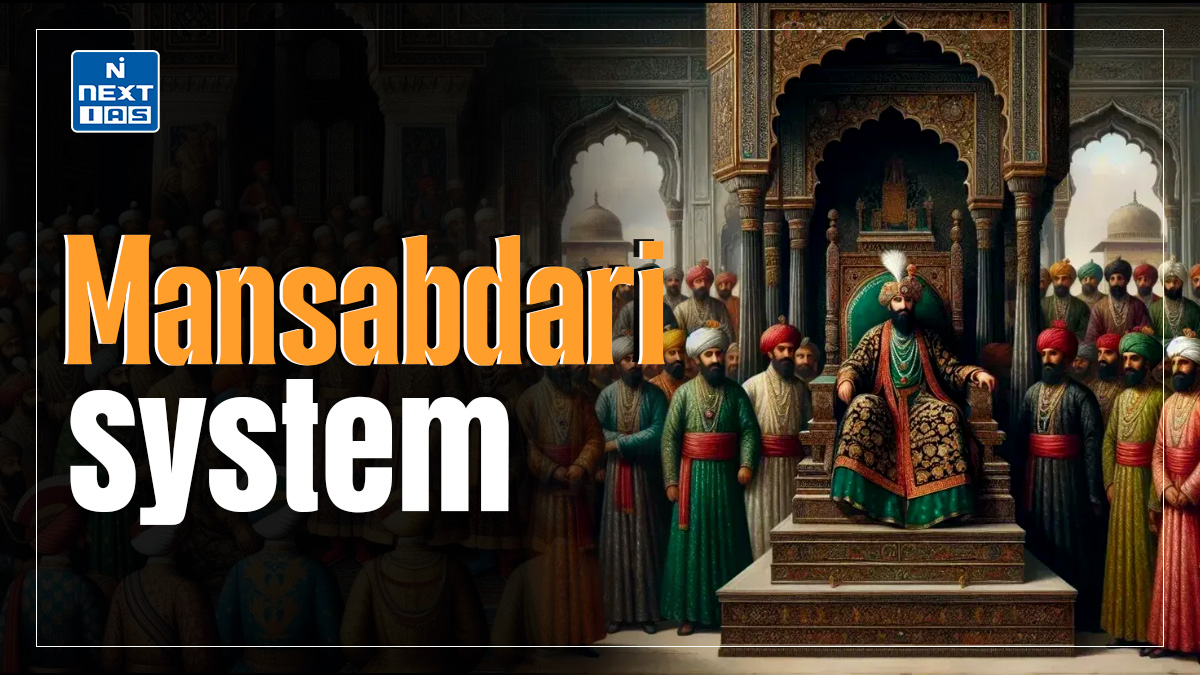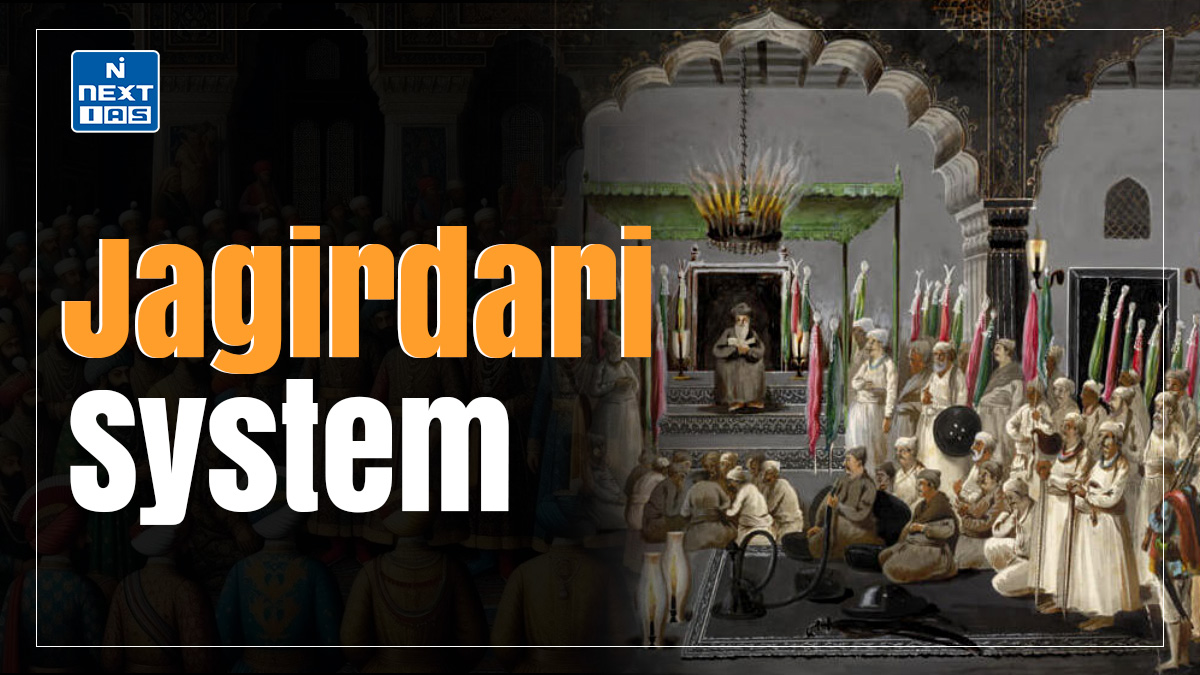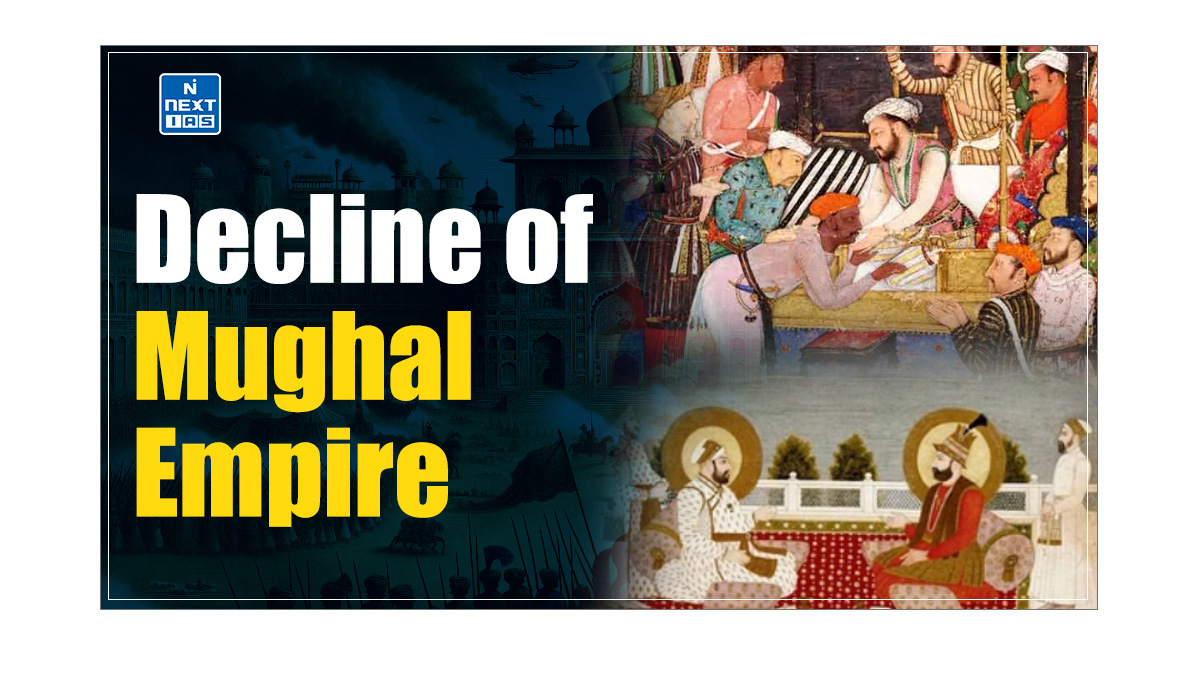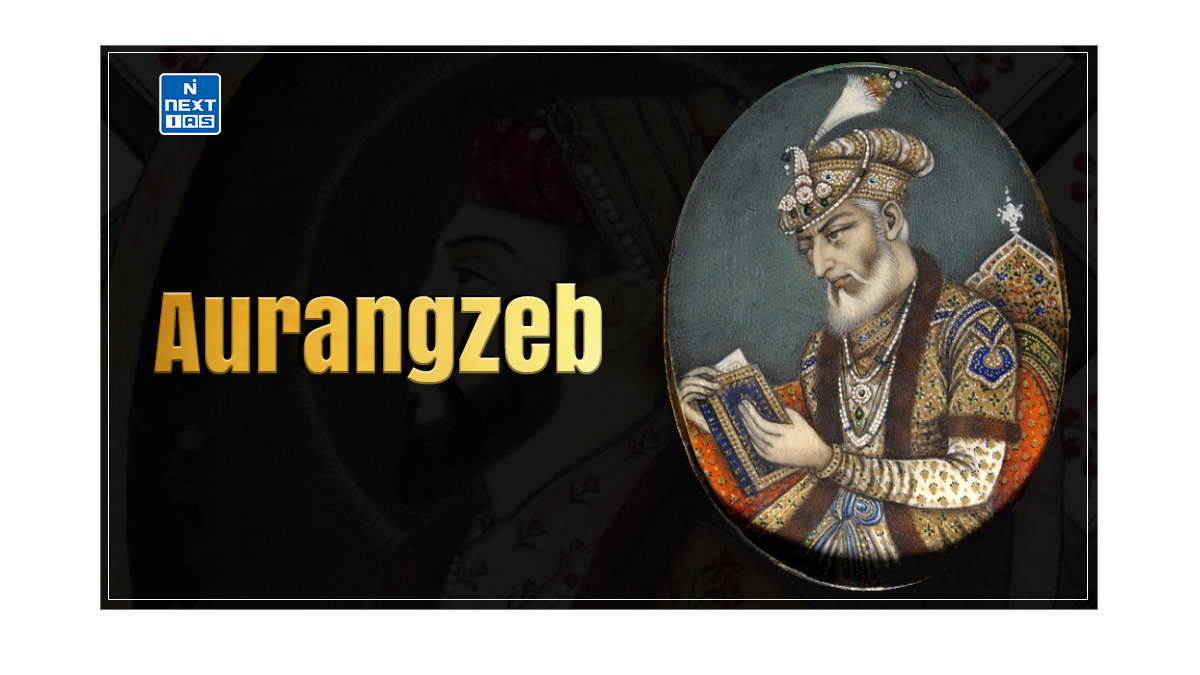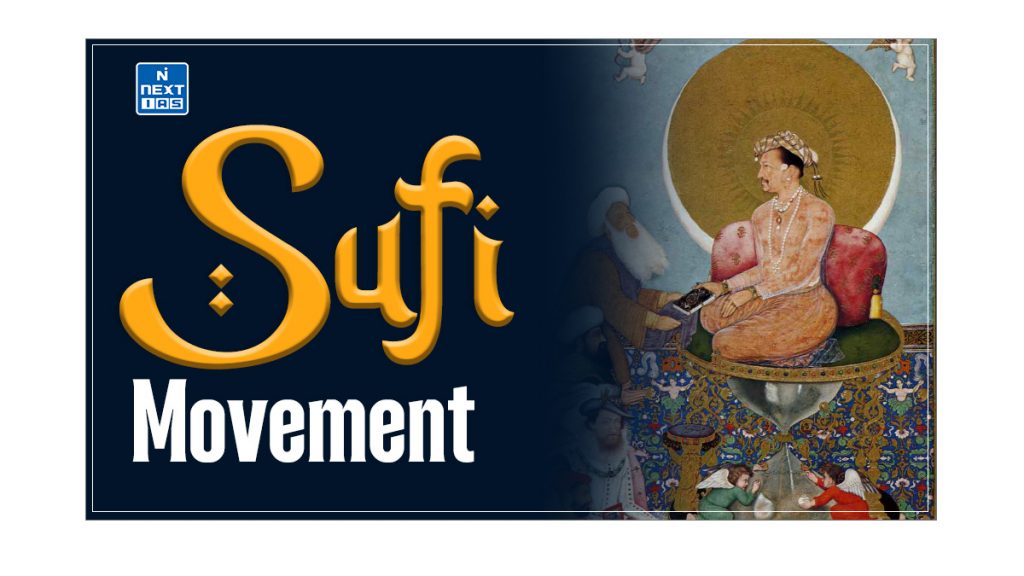
The Sufi Movement refers to the spread of Islamic mysticism in India. It emphasises personal devotion to God and a spiritual path focused on love and compassion. Its significance lies in promoting interfaith harmony and integrating local cultural elements, fostering a spirit of inclusivity and social unity. This article aims to study in detail the origins, philosophy, key figures, and contributions of the Sufi Movement in India.
About Sufi Movement
- Sufism is a combined name for mystical movements in Islam that aim to establish a direct communion between man and God.
- The methods of this communion were open to interpretation by the practitioner but within the realms of Islam.
- The Sufi order is also known as Silsila, in and outside India. Sufism stressed the importance of establishing communion between the Sufi and the god.
- A spiritual guru was required to supervise the method of communion with God. The path could be achieved by reciting musical poems praising God.
- Though no Sufi Silsilas were active in India from the early 8th to 10th century, some influence of Sufi culture can still be seen in India.
- Mansur al-Hallaj, a prominent early Sufi poet/teacher, gave the mystical formula “I am God,” which was essential in the evolution of Sufi ideas in Iran and India.
- Sufism became an organised movement with the establishment of Turkish rule under the Ghaznavids. It flourished under the Seljuqs in various parts of Central Asia, India, and Iran in the later 10th and 11th centuries.
- The Sufi movement gained prominence in Central Asia and Iran from the 8th to 12th century AD. Still, it only grew in India after the 13th century with great Sufis like Muinuddin Chisti.
History of Sufism in India
The history of Sufism in India can be traced back to the following points:
- Early Development and Islamic Mysticism: Sufism, often described as Islamic mysticism, emerged as a response to the formalism and rigidity of orthodox Islamic practices.
- It developed around the 8th century in the Middle East, focusing on the inner, personal experience of God (Allah), in contrast to the more legalistic and ritualistic approach of mainstream Islam.
- Sufis sought a more profound spiritual connection with God, emphasising love, inner purification, and the experience of divine presence through prayer, meditation, and self-discipline.
- Divergence from Orthodox Islam: While Islam traditionally emphasises adherence to Sharia (Islamic law), Sufism diverges by focusing on the faith’s esoteric and spiritual aspects.
- Orthodox Islam was primarily concerned with the outward expression of faith through prescribed rituals and social laws, while Sufism explored the inner journey of the soul towards divine truth (Haqiqa).
- Focusing on personal experience and direct communion with God sets Sufism apart from orthodox Islam’s more structured external practices.
- Arrival of Sufi Saints in India (12th Century Onward): Sufism began spreading to India during the 12th century with the arrival of Sufi saints from Central Asia and Persia.
- These saints were missionaries who came along with traders, soldiers, and Islamic rulers.
- They were deeply spiritual figures who, unlike many orthodox Islamic scholars, emphasised love, peace, and the universal brotherhood of humanity, which made their teachings appealing to the diverse populations of India.
Philosophy of Sufism in India
- Personal Devotion to God and Spiritual Closeness: At the heart of Sufism is cultivating a personal and intimate connection with God. Sufis emphasise that true spirituality comes from within, through a deep sense of devotion, love, and surrender to the divine.
- The ultimate goal is to experience God’s presence in everyday life, transcending the external aspects of religion and focusing on inner purity and love.
- Concepts of Fana and Baqa: Sufi philosophy includes the concept of Fana (self-annihilation), where the individual ego and worldly desires are dissolved in God’s presence, leading to complete selflessness.
- Once this state is attained, the Sufi moves towards Baqa (eternal existence in God), where they exist harmoniously with the divine.
- This journey of the soul from separation to unity with God forms the spiritual path of the Sufi.
- Zikr (Remembrance of God), Meditation, and Ascetic Practices: Sufis practice Zikr, a form of remembrance of God. This practice often involves repeating divine names or phrases to focus the mind and heart on God.
- Combined with meditation and asceticism, this practice helps purify the soul and cultivate inner awareness.
- Sufis often renounce material pleasures, living simple lives to remove distractions and focus on their spiritual path.
- Universal Love and the Oneness of All Creation: Sufism teaches that the entire creation is interconnected and reflects God’s presence. The Sufi philosophy of universal love transcends the barriers of religion, race, and caste.
- Love is the most powerful force that unites all beings with God and one another.
- This inclusive worldview promotes compassion, tolerance, and the idea that all creation is an expression of the divine.
Sufi Orders in India
- Chishti Order: The Chishti Order is one of India’s most influential Sufi orders. Introduced by Khwaja Moinuddin Chishti in the 12th century, it is known for its emphasis on love, tolerance, and service to humanity.
- The order became closely integrated with Indian culture. Khwaja Moinuddin Chishti, known as Gharib Nawaz (protector of the poor), promoted compassion, generosity, and hospitality values.
- His message of inclusivity resonated with people of all backgrounds, making the Chishti Order a powerful spiritual movement.
- The Chishti saints, such as Nizamuddin Auliya and Baba Farid, furthered this legacy, focusing on public welfare, providing food to the needy, and teaching that love for God can be achieved through love for all human beings.
- Suhrawardi Order: Founded by Bahauddin Zakariya in Multan, the Suhrawardi Order was known for its relatively more orthodox approach than the Chishti Order.
- It combined mysticism with Islamic jurisprudence, ensuring followers maintained a balance between Sufi spirituality and Islamic law.
- The Suhrawardi Order also valued interacting with political authorities, unlike the Chishti saints, who preferred to remain distant from rulers.
- Suhrawardi leaders frequently advised or mediated with political figures, making them key players in the socio-political landscape of medieval India.
- Qadiri Order: The Qadiri Order, founded by Sheikh Abdul Qadir Jilani in Baghdad, spread to India in the 16th century. It was known for emphasising personal piety, self-discipline, and devotion to God.
- While not as prominent as the Chishti or Suhrawardi orders regarding political influence, it gained a dedicated following, especially in the Deccan and Punjab regions.
- This order stressed the importance of living a pure, spiritual life in accordance with Islamic teachings, and its followers often engaged in Zikr, charity, and community service.
- Naqshbandi Order: The Naqshbandi Order stands out for its practice of silent Zikr (remembrance of God), in contrast to the vocal forms of Zikr used by other Sufi orders.
- Introduced in India by Khwaja Bahauddin Naqshband, this order became influential during the Mughal era, particularly under the leadership of Sheikh Ahmad Sirhindi.
- Sirhindi sought to revive orthodox Sunni Islam and counter what he viewed as excessive syncretism in the Mughal court, especially during Akbar’s reign.
Key Sufi Saints in India
- Khwaja Moinuddin Chishti (Ajmer): Khwaja Moinuddin Chishti, also known as Gharib Nawaz (Benefactor of the Poor), played a crucial role in spreading Sufism in India through his message of love, harmony, and service to humanity.
- Arriving in India during the 12th century, his teachings focused on compassion for the underprivileged and the unity of all people, regardless of religion or status.
- His Dargah in Ajmer, Rajasthan, known as Ajmer Sharif, has become one of India’s most important pilgrimage sites. It attracts millions of Muslim and non-Muslim devotees who come to seek blessings and spiritual solace.
- Nizamuddin Auliya (Delhi): Nizamuddin Auliya was one of the most famous Sufi saints of the Chishti Order and is remembered for his emphasis on tolerance, charity, and social welfare.
- His spiritual teachings focused on the importance of love for God, expressed through love for all humanity, transcending caste, creed, and wealth divisions.
- The Nizamuddin Dargah in Delhi, built around his tomb, remains a vital cultural and spiritual centre.
- Even today, it serves as a hub for qawwali performances and attracts devotees from diverse backgrounds, continuing his legacy of inclusivity and compassion.
- Baba Farid (Punjab): Baba Farid, also known as Fariduddin Ganjshakar, was instrumental in spreading the Chishti order in Northern India, particularly in the Punjab region.
- His teachings, deeply rooted in humility and devotion to God, resonated with the local population and played a key role in establishing the Chishti Sufi tradition in the area.
- Baba Farid’s poetry and hymns, some of which are included in the Guru Granth Sahib (the holy book of the Sikhs), reflect his emphasis on simplicity, devotion, and spiritual surrender, bridging the gap between Hinduism, Sikhism, and Islam.
- Sheikh Salim Chishti (Fatehpur Sikri): Sheikh Salim Chishti was a revered Sufi saint of the Chishti order during the Mughal era, known for his spiritual influence on Emperor Akbar.
- It is said that Akbar sought his blessings for a male heir, and when his wish was fulfilled, he named his son Salim (later Emperor Jahangir) in honour of the saint.
- The tomb of Sheikh Salim Chishti, located at Fatehpur Sikri near Agra, is an architectural marvel and a primary pilgrimage site. His relationship with the Mughal emperors highlights the deep connection between Sufi saints and political figures of the time.
- Hazrat Amir Khusro: Hazrat Amir Khusro, a disciple of Nizamuddin Auliya, was a prolific poet, musician, and scholar who left a lasting legacy on Indian culture.
- Credited with developing the Qawwali form of devotional music, Khusro’s contributions to Indian music and literature were profound.
- He is often regarded as the “father of Qawwali” and significantly influenced the evolution of classical Hindustani music.
- Khusro’s work as a poet, particularly his use of Persian, Urdu, and Hindi in his compositions and his innovative blending of Indian and Persian musical traditions, made him a cultural bridge between different communities.
- His deep devotion to Nizamuddin Auliya is legendary, and his literary and musical contributions remain a cornerstone of Sufi cultural expression in India.
Role of Sufi Saints (Pirs) in India
- Sufi saints, known as Pirs or Sheikhs, are seen as spiritual guides who help their disciples, Murids, on their journey toward divine realisation.
- The relationship between the Murshid (teacher) and Murid (disciple) is central to Sufi practice.
- The Pir offers wisdom, teachings, and guidance to help the disciples achieve spiritual growth and understanding, often leading them through the Sufi practice and experience stages.
- Dargahs, the shrines built over the graves of Sufi saints, are both spiritual centres and hubs of social and cultural interaction.
- They attract followers from all faiths and social backgrounds, offering a space where people can come together for prayer, meditation, music, and charity.
- Dargahs also serve as places of community support, where the poor and needy can seek aid. These shrines’ atmosphere of inclusion and unity makes them significant spiritual and social institutions in India.
Social and Religious Contributions of Sufism in India
- Interfaith Harmony: One of the Sufi movement’s most significant contributions in India was promoting communal harmony between religious communities, particularly Hindus and Muslims.
- Sufi saints emphasised inclusive spiritual practices that transcended religious divisions, focusing on universal values such as love, devotion to God, and service to humanity.
- Their message of unity resonated with followers from various backgrounds, creating a shared space for worship and dialogue.
- Upliftment of the Marginalized: The Sufi movement played a crucial role in the upliftment of marginalised communities, including women, lower castes, and the poor.
- Sufi saints preached a message of equality and universal brotherhood, emphasising that all human beings, regardless of their social standing, are equal in God’s eyes.
- This message was especially empowering for those oppressed by the time’s rigid social and caste structures.
- Challenge to Orthodox Islam and Caste System: The Sufi emphasis on love, devotion, and personal experience of the divine contrasted with the ceremonial practices of orthodox Islam, which often focused on legalism and adherence to external rites.
- Sufis rejected the idea that rigid rituals were necessary for spiritual progress and instead taught that true devotion and connection with God came from within.
- This approach made Sufism accessible to the masses, including those excluded from orthodox religious practices.
Bhakti and Sufi Movement
- The Bhakti and Sufi movements emerged in India during the medieval period as powerful expressions of spiritual devotion transcending rigid religious boundaries.
- Bhakti, rooted primarily in Hindu traditions, emphasised personal devotion to deities and the importance of love and surrender to God, often articulated through poetry and song.
- Sufi mysticism, associated with Islam, focuses on the inner experience of the divine. It promotes love, tolerance, and the pursuit of truth through practices like meditation and poetry.
- Both movements championed egalitarianism, sought to connect individuals directly with the divine, and challenged societal hierarchies, fostering a spirit of inclusivity that resonated across diverse communities.
Conclusion
The Sufi Movement was crucial in promoting interfaith harmony and social upliftment in India. Through their love, equality, and devotion teachings, Sufi saints helped bridge religious divides and offered solace to the marginalised. Their legacy continues to inspire, with Sufi shrines as enduring symbols of spiritual unity and compassion.
Frequently Asked Questions (FAQs)
What is Sufi Movement?
The Sufi Movement is a mystical branch of Islam that emphasises direct personal experience of God through love, devotion, and spiritual practices. Sufis seek to achieve a deeper connection with the divine, often through poetry, music, and rituals, promoting values such as tolerance, compassion, and unity.
What is the difference between Bhakti and Sufi Movement?
The Bhakti Movement focuses on devotion to Hindu deities and emphasises personal love for God, often through poetry and song. In contrast, the Sufi Movement is rooted in Islam and seeks a direct, mystical connection with the divine, highlighting inner experiences and universal love. While both promote devotion and inclusivity, their cultural contexts and practices differ significantly.
